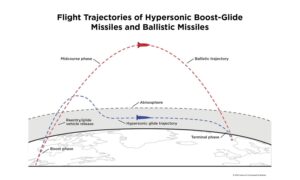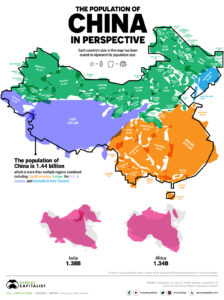Link : https://fb.watch/9fxX7_M1QD/
Suggestions and value additions are most welcome
For regular updates, please register here
Link : https://fb.watch/9fxX7_M1QD/
Suggestions and value additions are most welcome
For regular updates, please register here

Pic Courtesy: France 24
Emerging class of missile technologies include manoeuvrable vehicles that carry warheads through the atmosphere at more than five times the speed of sound. Hypersonic glide vehicles (HGVs), like all weapons delivered by medium and longer range rocket boosters, can travel at speeds of at least Mach 5, or about 1 mile per second. The key difference between missiles armed with HGVs and missiles armed with ballistic re-entry vehicles (i.e., those that travel on a ballistic trajectory throughout their flight) is not their speed, but their ability to manoeuvre and change course after they are released from their rocket boosters. Hypersonic weapons can be classified into two distinct categories:

Pic Courtesy: PTs IAS Academy

Pic Courtesy: Union of Concerned scientists
The flight of hypersonic boost-glide vehicle is divided into six stages: boost, ballistic, re-entry, pull-up, glide, and terminal phases. In the boost phase, a rocket booster accelerates the missile carrying the hypersonic vehicle until the booster exhausts its fuel, at which point it detaches from the glide vehicle and falls back to Earth. In the ballistic phase, the vehicle travels above the atmosphere on a ballistic trajectory under only the influence of gravity. Both of these phases are comparable to a ballistic missile launch. Hypersonic trajectories diverge from those of ballistic missiles in the re-entry and pull-up phases. Here, the vehicle pierces the upper atmosphere, then slows its descent to enter a stable glide trajectory. In the glide phase, the vehicle generates aerodynamic lift to sustain near-level flight. Finally, in the terminal phase, the glider dives toward its target.
These weapons outperform existing missiles in terms of delivery time and evasion of early warning systems. Their flight characteristics are distinct from those of typical ballistic missiles, which spend most of flight above the atmosphere and are capable of only limited manoeuvrability, and from those of subsonic or supersonic cruise missiles, which travel through the atmosphere but fly more slowly.

pic courtesy: Visualcapatalist.com
Population
The current population of China is 1,446,554,428 (as of Thursday, October 21, 2021, based on World meter elaboration of the latest United Nations data).
China ranks number 1 in the list of countries by population.
China population is equivalent to 18.47% of the total world population.
Population Trend
50 years back China had touched growth rate of 2+ by percentage.
The growth rate has come down to about 0.4 percent now.
If present trend continues, zero growth rate will be reached somewhere between 2030 and 2035.
Thereafter it will be in negative.
By 2030 China will not be the most populace country. It will drop to number 2 position.
Population control
Initially, China’s post-1949 leaders were ideologically disposed to view a large population as an asset. But the liabilities of a large, rapidly growing population soon became apparent.
In 1972 and 1973 the party mobilized its resources for a nationwide birth control campaign administered by a group in the State Council. Population growth targets were set for both administrative units and individual families. In the mid-1970s the maximum recommended family size was two children in cities and three or four in the country.
One Child Policy. Since 1979 the government has advocated a one-child limit for both rural and urban areas and has generally set a maximum of two children in special circumstances. The overall goal of the one-child policy was to keep the total population within 1.2 billion. The one-child policy was unique, however, in that it linked reproduction with economic cost or benefit. Under the one-child program, a sophisticated system rewarded those who observed the policy and penalized those who did not. Through this policy, the rate of increasing population was tempered after the penalties were made. Couples with only one child were given a “one-child certificate” entitling them to such benefits as cash bonuses, longer maternity leave, better child care, and preferential housing assignments. In return, they were required to pledge that they would not have more children. The one-child policy enjoyed much greater success in urban than in rural areas.
Rapid fertility reduction associated with the one-child policy has potentially negative results in terms of increase in median age.
Median Age and Trend
The median age in China is 38.4 years.
50 to 60 years back it was close to 20 years.
If present trend continues, the median age of china will touch close to 50 years by 2050.
Even though China has already opened two-child policy since 2016, data shows that the second-child policy cannot stop the problem of an aging population.
Population Density.
The population density in China is 153 per Km2 (397 people per mi2).
50 years back this figure was about 90.
By 2050, it will touch a figure of 150.
Distribution
Broadly speaking, the population is concentrated in the east.
The most densely populated areas included the Yangtze River Valley (of which the delta region was the most populous), Sichuan Basin, North China Plain, Pearl River Delta, and the industrial area around the city of Shenyang in the northeast.
Population is most sparse in the mountainous, desert, and grassland regions of the northwest and southwest.
In Inner Mongolia Autonomous Region, portions are completely uninhabited, and only a few sections have populations denser than ten people per km2. The Inner Mongolia, Xinjiang, and Tibet autonomous regions and Qinghai and Gansu comprise 55% of the country’s land area but in 1985 contained only 5.7% of its population.
Urban / Rural Distribution and trend
60.8 % of the population is urban.
50 years back this percentage was about 20%.
By 2050, the urban population would touch about 80 %.
Largest Cities in China (by Population) are:-
| CITY NAME | POPULATION | |
| 1 | Shanghai | 22,315,474 |
| 2 | Beijing | 11,716,620 |
| 3 | Tianjin | 11,090,314 |
| 4 | Guangzhou | 11,071,424 |
| 5 | Shenzhen | 10,358,381 |
| 6 | Wuhan | 9,785,388 |
| 7 | Dongguan | 8,000,000 |
| 8 | Chongqing | 7,457,600 |
| 9 | Chengdu | 7,415,590 |
| 10 | Nanjing | 7,165,292 |
Other Figures and Trends
According to the 2020 census, 91.11% of the population is Han Chinese, and 8.89% are other minorities.
Life expectancy is 77.5. This figure was close to 45 years about 70 years back and about 60 50 years back.
Infant Mortality rate is 8.4 per 1000 births.
Suggestions and value additions are most welcome
For regular updates, please register here
References
https://www.statista.com/statistics/263765/total-population-of-china/
https://en.wikipedia.org/wiki/Demographics_of_China
https://data.worldbank.org/indicator/SP.POP.TOTL?locations=CN
https://www.visualcapitalist.com/the-population-of-china-compared-with-the-rest-of-the-world/